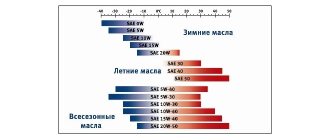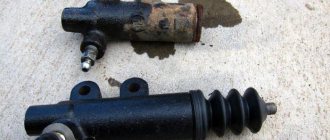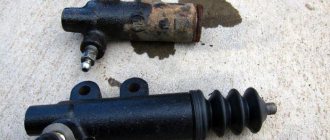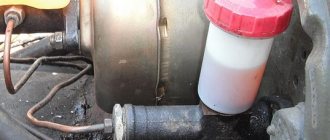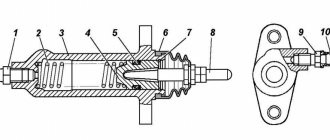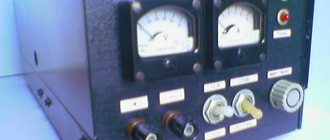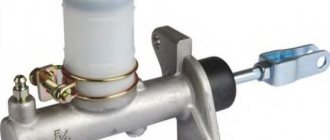GAZ-4301 serial production since 1984
GAZ-4301 is a fourth generation diesel truck produced by GAZ. Load capacity 5 tons. The development and assembly of the first car was completed in 1984. The GAZ-4301 family was radically different from the cars of the previous “fifty-third” series in two ways: the use of a diesel engine and the possibility of constant operation as part of a road train, which was incorporated at the design stage.
photo GAZ-4301
Initially, the chassis was intended for universal use, so many components of third-generation trucks were radically redesigned to strengthen them, and some were even developed anew (including the rear axle with an optional differential lock, gearbox, suspension, front axle, frame, driveline). In addition, the GAZ-4301 received a completely new dual-circuit brake system with hydraulic drive and two pneumatic boosters. The wide track of the front and rear wheels and the low center of gravity ensured good stability of the vehicle. Innovations include: power steering, a device to facilitate engine starting, increased interior comfort, and an improved heating system.
photo GAZ-4301
“GAZ-4301” and “GAZ-3307”, these cars were practically the same in appearance. The external distinctive features of the GAZ-4301 are the high-mounted air intake pipe; a frame that on this LAWN is more powerful and wider than that of its gasoline “brother”; as well as wheels with other ventilation holes that are suitable only for this model. Another difference between the GAZ-4301 and GAZ-3307 can be found on the left side of the frame behind the cab in front of the fuel tank - these are two main brake cylinders with pneumatic boosters.
Brake system and chassis
The car's braking system is made with a high percentage of reliability of all components. There are two separate actuators capable of operating dual-circuit brake units at each wheel.
The length of a car's braking distance greatly depends on the load distribution on each wheel. It is very important that one of the pairs of wheels does not lock prematurely.
Important! If the front wheels are blocked, the car loses control, and when the rear wheels go into skid braking mode, there is a high probability of skidding. To avoid these consequences, it is necessary to correctly distribute the braking torque - equally on all four wheels.
Under this condition, maximum safety of the process itself and minimum braking distance are ensured.
When braking, the vehicle's dynamic center of gravity redistributes the load on the axles: approximately 60% on the front and 40% on the rear.
As a result, the front wheels are adjusted to more intense locking.
It was to increase reliability and safety that the designers provided two brake systems with one hydraulic drive and two pneumatic boosters.
The GAZ-4301 is also equipped with a brake system with a pneumatic installation for a trailer.
The truck is equipped with brake drums on 4 wheels, which are made of cast iron.
This mechanism provides a device for automatically controlling the air gap between the block and the drum.
All four drums are easily removable, allowing access to system maintenance.
The parking brake is provided by a manual drive with a gear mechanism, and the pads are released only on the rear wheels.
The wheel rims are a unique element of this truck and are designed specifically for it. They have ventilation hatches, which increases airflow to the brake drums.
Wheel rims are centered by a hole that fits onto the edge of the hub, as opposed to the common flare nut system.
The diameter and class of tires are determined by the series of intended use; for a given vehicle it is 8.25P20. Tires in this series have a ply level of HC12. The pressure in the front tires is normalized to 370 kPa, and in the rear – 540 kPa.
Engine GAZ-4301
The GAZ-4301 trucks were equipped with six-cylinder 125-horsepower air-cooled diesel engines GAZ-542.10. This was the first diesel engine developed by specialists at the Gorky Automobile Plant. To introduce it into production, they used licensed German technologies. The cylinders of this motor are easily removable, with external fins. The oil cavity at the cylinder-crankcase interface is sealed with a copper gasket. The cylinder heads are separate for each cylinder, with external and internal fins to ensure cooling by passing air, with insertable cast-iron seats and valve guides, with V-shaped valves. The pistons have three compression rings and one oil scraper ring. Connecting rods - with an oblique connector of the lower head. The connecting rod is finished together with the cap, so the connecting rod caps are not interchangeable. The crankshaft is seven-bearing, with removable counterweights. The engine is equipped with an overhead valve timing mechanism with a lower camshaft. The camshaft here is seven-bearing, at the rear end of which there is a timing gear. With its help, through the crankshaft gears, the camshaft is driven. The high-pressure fuel pump (HFP) is in-line, with a mechanical two-mode centrifugal regulator. The low pressure fuel pump is a piston type. The fuel pump is a plunger pump with manual fuel pumping. The GAZ-542 .10 engine uses closed-type injectors, the pressure at which the needle begins to rise is 22 MPa (220 kgf/cm2). The cooling system is air, with a gear-driven fan through an adjustable fluid coupling. There are two filters for the fuel system: coarse filter (sump filter with a mesh element) and fine filter (with replaceable paper filter elements). The engine air filter is installed with a replaceable element and a maximum fullness indicator.
photo engine GAZ-4301
Truck Specifications
Dimensions:
- length – 6330 mm;
- width – 2380 mm;
- height – 2350 mm.
Platform dimensions:
- length – 3490 mm;
- width – 2170 mm;
- height – 510 mm;
- wheelbase - 3770 mm;
- ground clearance - 236 mm;
- loading height, mm - 1350.
Load capacity - 3000 kg. Gross weight - 7850 kg. Curb weight - 3100 kg.
Engine – diesel / petrol:
- volume - 4.25 l;
- power - 85 l. With. / 125 l. With.;
- fuel consumption - 13 l / 20 l / 100 km;
- fuel tank volume - 100 l;
- fuel consumption per 100 km - 13 l;
- maximum speed, km/h - 85.
Transmission - manual 4-speed.
Transmission GAZ-4301
The transmission of the GAZ-4301 truck includes a single-plate closed dry friction clutch with a diaphragm spring and a hydraulic drive. As well as a manual five-speed gearbox, three-way, with synchronizers in all gears except first and reverse. There are two synchronizers at this gearbox, of the inertial type. First gear and reverse gear are engaged by a gear clutch. Gear ratios: I - 6.286; II - 3.391; III - 2.133; IV - 1.351; V - 1.0; reverse gear - 5.429. Cardan transmission - two open shafts with an intermediate support; three universal joints on needle bearings. The main gear is a conical, hypoid type. Gear ratio - 5.857. Differential - bevel, gear, with forced locking. The locking mechanism is controlled remotely by a pneumatic valve.
Why was the GAZ-4301 truck discontinued?
Despite the fact that the first production diesel truck of the Gorky Automobile Plant was reliable and quite high-tech, its production was curtailed in 1995. This was due to several reasons:
- Although the first diesel engine from GAZ was quite economical and powerful, there were practically no craftsmen in the country who understood diesel equipment. GAZ-4301, the engine of which could not be repaired on collective farms, was doomed to long downtime after breakdowns;
- The vehicle's insufficient cross-country ability was due to the peculiarities of its design. The diesel engine was too heavy, which put a high load on the front axle. This in turn led to the machine easily getting stuck on soft soils and in mud;
- The global crisis of the early 1990s led to a drop in demand for trucks;
- The cessation of government funding for the plant led to the fact that the plant simply could no longer produce diesel engines.
Suspension GAZ-4301
The GAZ-4301 uses a front suspension on two longitudinal semi-elliptic springs, with an additional rubber compression spring. The rear suspension is based on two longitudinal semi-elliptical springs with additional metal springs and shock absorbers. The shock absorbers on the front axle are hydraulic, telescopic, double-acting. To increase the energy capacity of the springs and limit their deflection, rubber compression springs are installed on the frame side member in the area of the front axle. Rubber buffers are also installed on the lower flange of the rear frame side members, above the rear axle, to limit the degree of spring deflection.
Chassis and steering
The car suspension is designed to combine the body and supporting frame with the wheel part.
Its main task is to correctly distribute the loads experienced by the body during driving and reduce the negative impact of impacts.
A well-designed suspension ensures smooth, comfortable movement, improves traction characteristics and a stable position of the truck on the road.
The front suspension of the GAZ-4301 uses semi-elliptical springs with the ability to adjust compression using rubberized spacers.
The rear suspension combines spring and spring suspension types. Telescopic shock absorbers cope with their task and smooth out all vibrations and impacts on the truck body.
Hydraulic shock absorbers are installed and attached to the frame and axle supports.
The steering system of the car is equipped with a hydraulic booster. This ensures easy steering and driver comfort with less fatigue.
The wheel turning mechanism is equipped with a globoidal-type worm gear and a three-ridge wheel mounted on a bearing.
This system made it possible to isolate the steering wheel directly from vibrations and impacts from uneven road surfaces.
The use of hydraulic reinforcement made it possible to reduce the number of steering wheel revolutions from the left extreme position to the right and vice versa. This increased the popularity of the car for urban cargo transportation.
The stability of the car was increased by improving many components: a low center of gravity, the distance between the wheel tracks was increased, the rear differential was locked by a remote pneumatic system, and the design of the gearbox was improved.
Photos of GAZ-4301
photo GAZ-4301
photo GAZ-4301
photo GAZ-4301
About the history of the model
The development of the GAZ-4301 truck model started at the Gorky Automobile Plant back in the early 80s. In 1982-1983, a pilot batch of these machines underwent serious testing. Since such trucks were intended mainly for agriculture, the first tests were carried out on collective farms near Moscow. Then a test motor rally of nine thousand kilometers was organized - from Gorky to Kuibyshev, then to Aralsk, Tashkent, with the finish line in the Pamir Mountains.
The tests were successful, but the diesel GAZ-4301 reached mass production only in 1992. In a country with a planned economy and absolute dominance of the state in all spheres of the economy, there was no urgent need to switch to diesel cars, although it was recognized that it needed to be ensured. Gasoline was still cheap, and car factories were consistently supplied with orders for gasoline trucks.
In parallel with the production of the GAZ-4301 on the assembly line, the production of a dump truck “agricultural truck” on its chassis was organized - under the GAZ-SAZ-4509 brand. This agricultural grain dump truck was intended to work as part of the 8.6-ton GAZ-6008 dump truck train (together with the GKB-8536 trailer). In general, the prospects for the GAZ-4301 truck in Soviet-style agriculture would be good. However, after the collapse of the USSR, there was no agriculture in the country, at least in its previous form. It was completely destroyed.
A note from 1984 about the prototype of the GAZ-4301 diesel dump truck “agricultural truck”, exhibited at VDNKh.
Since the very concept of a truck created on the basis of the GAZ-3307 was archaic, and the economic conditions in the country had radically changed (no government subsidies, no demand for such vehicles), the new diesel truck was discontinued by 1995.
Release history
Trucks began to be produced at the capital's plant, it was ZIL, and the GAZ plant began developing a model code-named 4301. A leading group of design engineers worked on it. In the construction of this car, names such as Prosvirin and Butusov appear. It was thanks to them that this brand of GAZ truck type car was released at the end of 1982. The truck was tested for sowing and harvesting work for a whole year.
Then, the truck waited for a route 9 thousand km long.
